Chanterelle mushrooms are easy to identify and fun to forage for! They are delicious and a culinary treat to find in the wild. Learn how to identify chanterelle mushrooms, where to forage for them, and my favorite ways to cook with this very special edible wild mushroom. Let’s go foraging for chanterelle mushrooms!
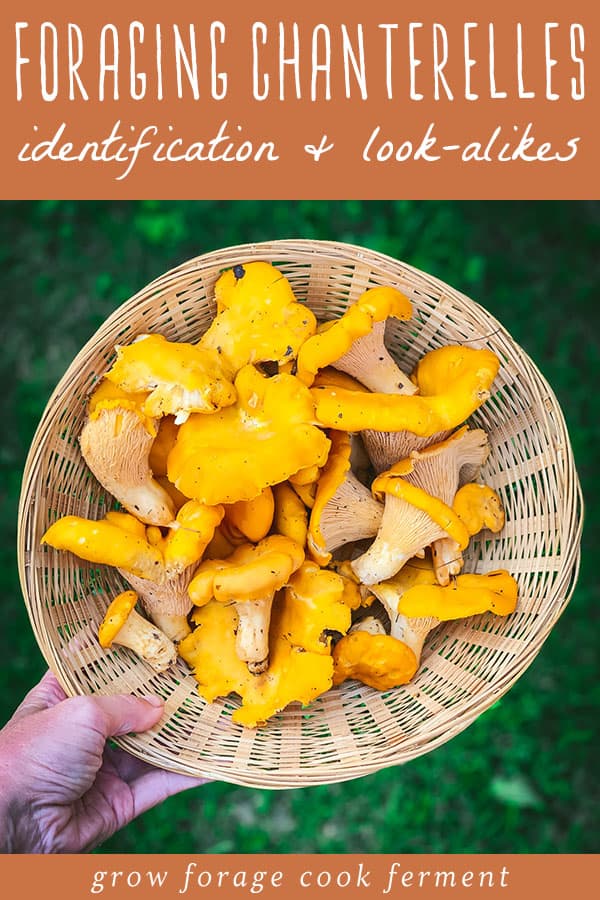
Wildcrafting Weeds
If you want to learn more about the edible and medicinal weeds that surround us and how to use them, check out my eBook: Wildcrafting Weeds: 20 Easy to Forage Edible and Medicinal Plants (that might be growing in your backyard)!
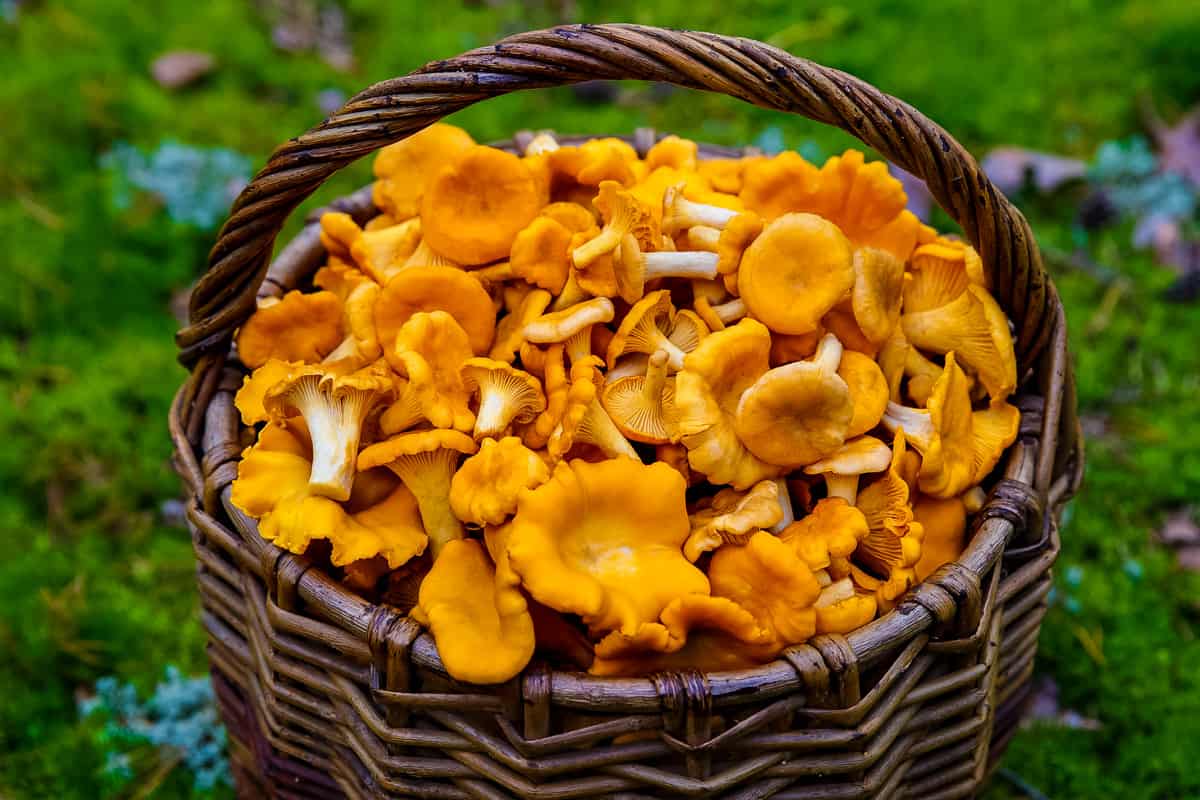
Foraging Chanterelles
I love foraging for chanterelle mushrooms! It is always so exciting to find a patch, and once you know what to look for they are one of the easiest mushrooms to identify.
There are several species of chanterelle mushrooms in the Cantharellus genus, with the most common species being Cantharellus cibarius (also known as girolle).
Other closely related species include yellowfoot chanterelles and black trumpet mushrooms.
Chanterelles are typically found from July through October depending on your region.
They are found in the summer in more humid regions that have summer rainfall, such as eastern North America and New England. In regions that have dry summers, like western North America, they don’t usually pop up until after fall rains in September or October.
Related: What to Forage in Fall: 30+ Edible and Medicinal Plants and Mushrooms
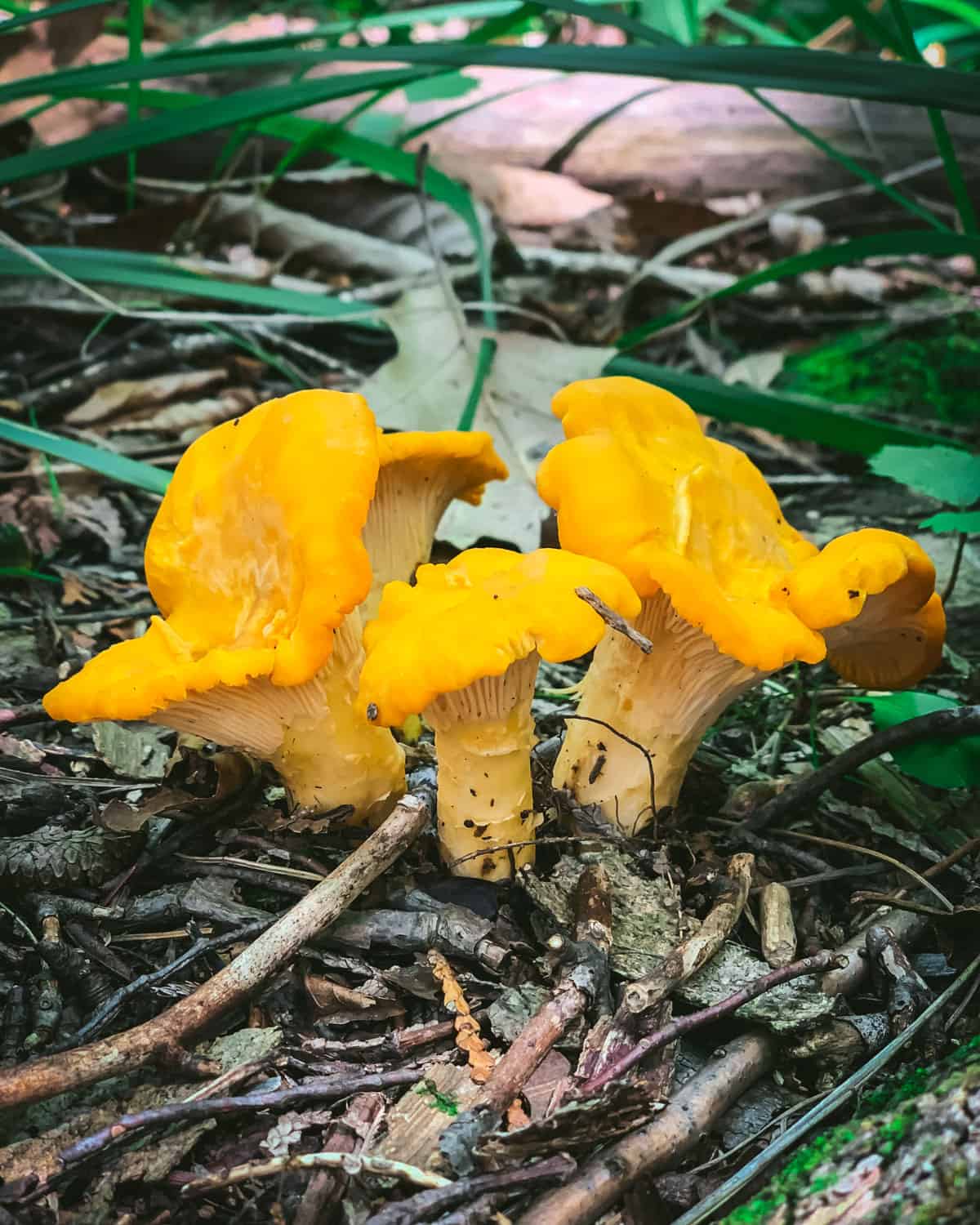
Where to Find Chanterelle Mushrooms
Chanterelle mushrooms are found in North America, Europe, Australia, and parts of Asia.
Chanterelles are woodland mushrooms that have strong mycorrhizal relationships with trees. They are most commonly found near hardwood trees, such as beech, oak, maple, birch, and poplar. They can also be found near conifers such as pine or hemlock.
Chanterelles love old growth forests with moist forest floors and often pop up after heavy rains. Mossy and damp forest clearings are another great place to look for them.
If you find one chanterelle chances are there are more in the area so keep looking!
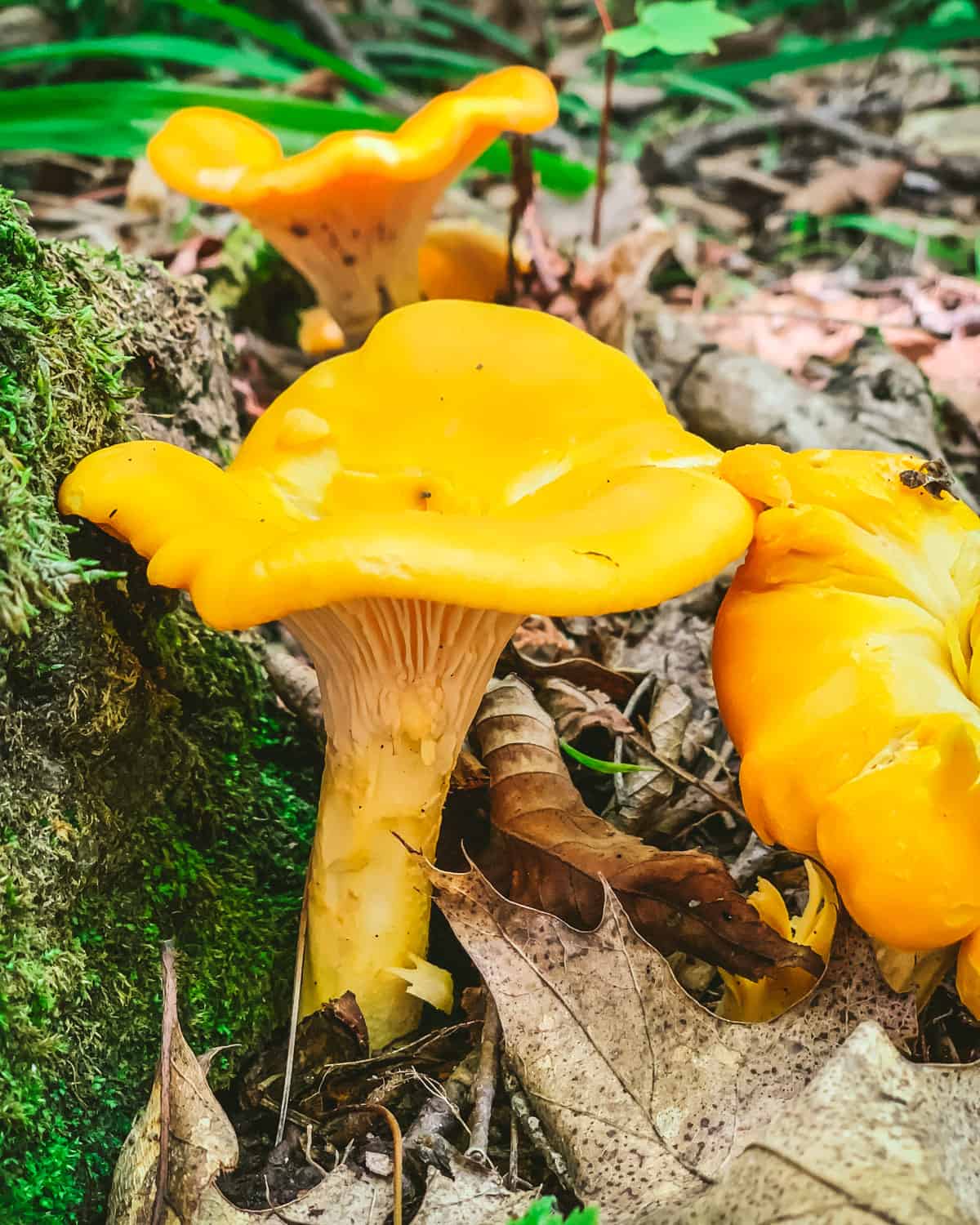
Identifying Chanterelle Mushrooms
There are a few key identification features of chanterelle mushrooms.
Chanterelles are usually relatively easy to spot because of their yellow-orange color, although in the fall the colorful leaves on the ground can make it more difficult. They can be anywhere from almost white to deep yellow or almost orange in color.
The cap of a chanterelle is flat at first, then funnel shaped. The edges curl with age and become wavy or lobed.
The stem is solid, continuous with the cap, smooth and paler in color at the base.
The flesh is firm and smells of apricots or fresh pumpkin. The inside is white when cut open.
Chantrelles do not have true gills, but rather blunt ridges that fork and extend down the stem. There are often connecting veins in between the ridges, especially on larger mushroom specimens.
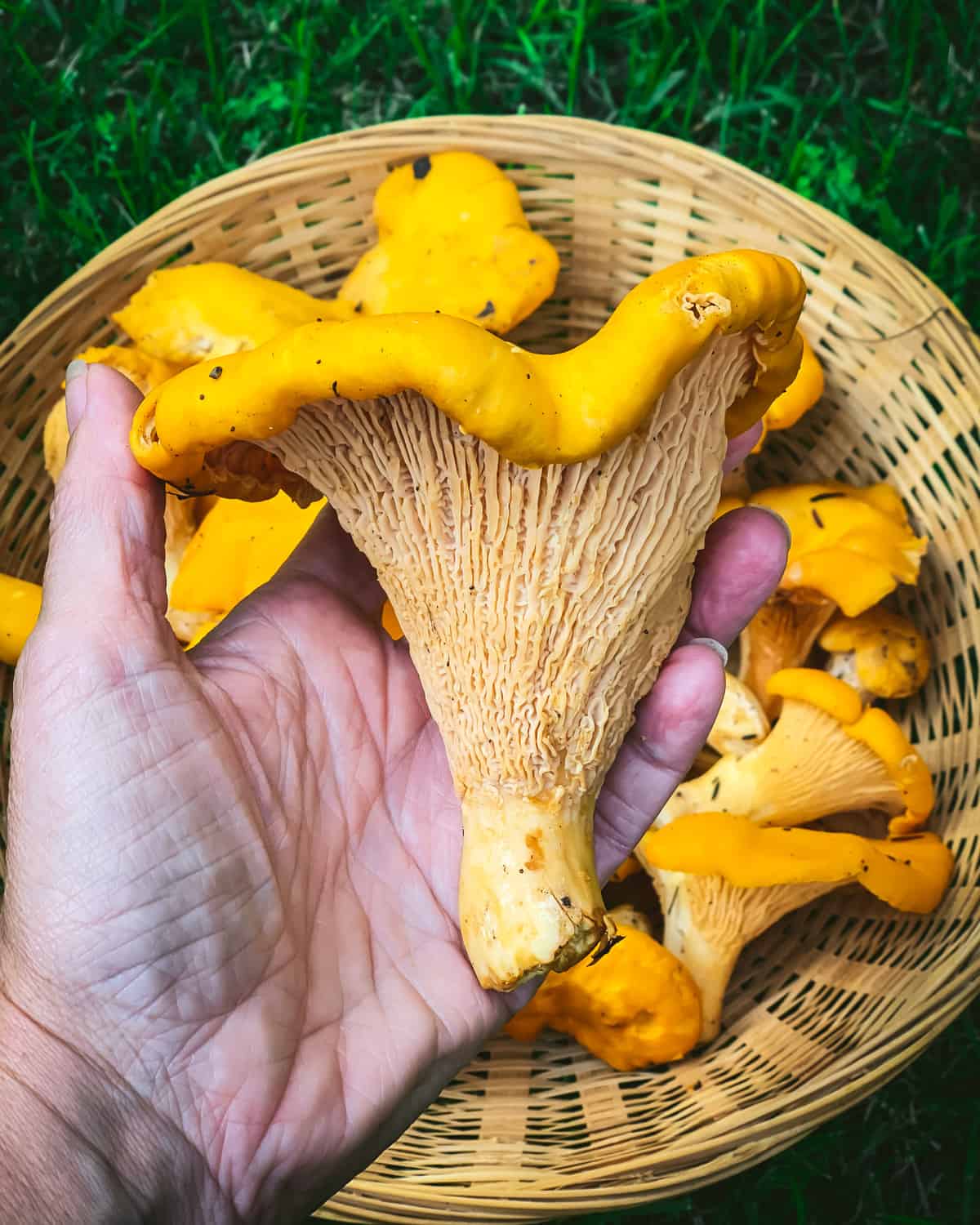
The spore print for chanterelles is pale cream in color.
Make sure that you double check any mushroom you might find with a mushroom guidebook for your region.
One of my favorite guidebooks is All That The Rain Promises and More by David Arora (it’s good for most regions even though the title says western).
If you really want to get more in depth on studying mushrooms, his book Mushrooms Demystified is also great.
Related: 12 Best Books on Foraging and Wildcrafting
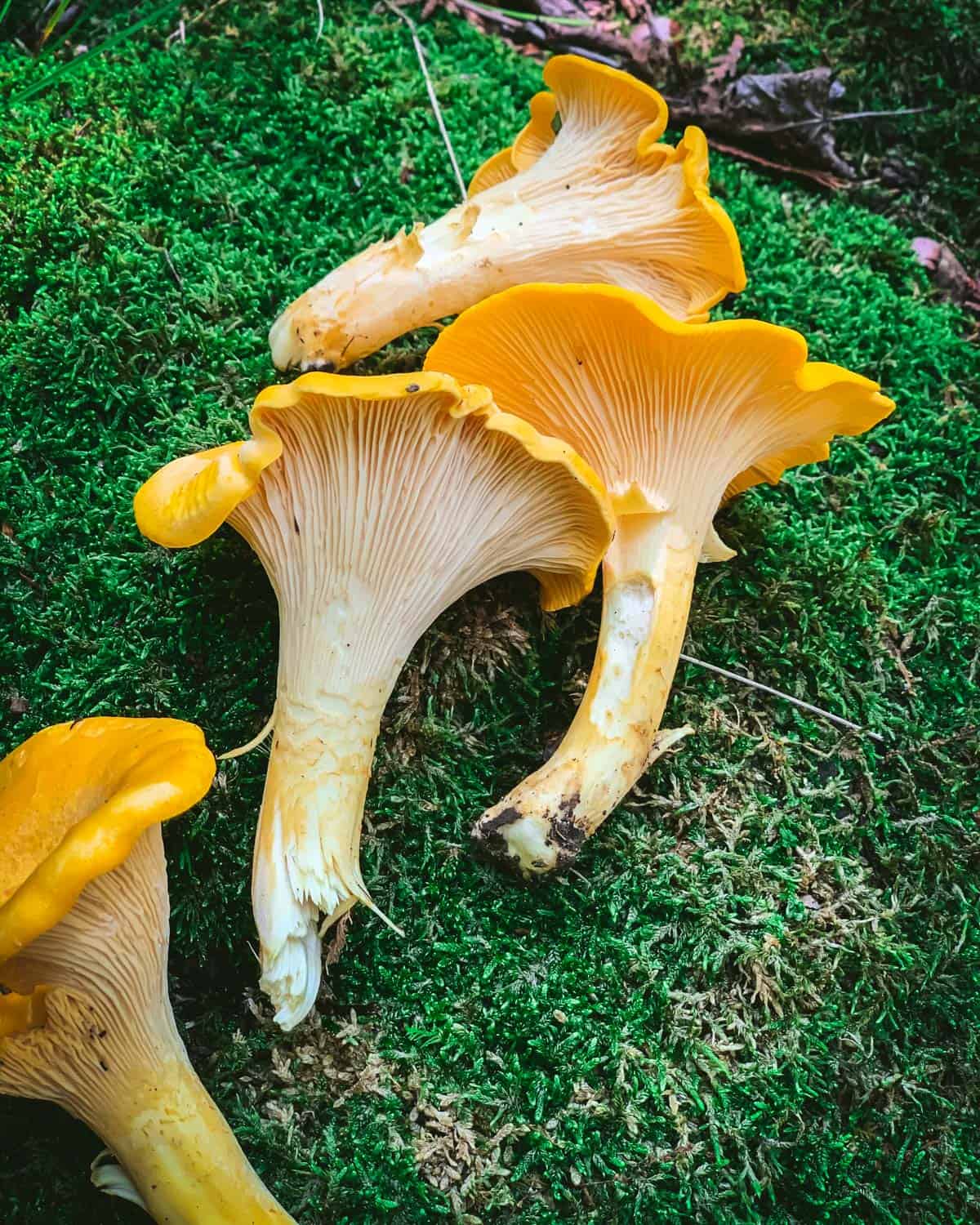
Chanterelle Mushroom Look-alikes
There are two chanterelle mushroom look-alikes that you need to be aware of.
The first one is called the Jack-o-lantern mushroom (Omphalotus illudens) which is highly toxic and can cause severe stomach upset. It is orange in color like chanterelles, but it has true gills (not blunt) with very little forking.
Jack-o-lanterns grow in clusters on decaying wood, similar to oyster mushrooms. Lastly, when cut open the interior is orange, rather than white like chanterelles.
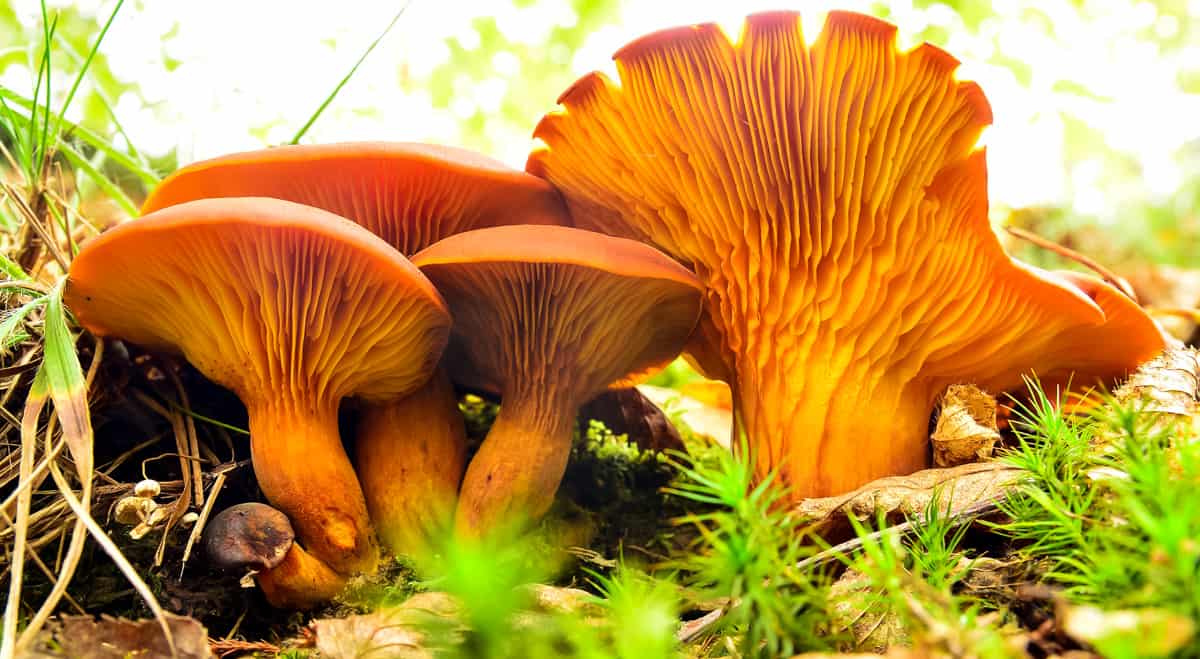
The other chanterelle mushroom look-alike is false chanterelle (Hygrophoropsis aurantiaca). They are mildly toxic and can cause gastrointestinal issues in some people.
False chanterelles are orange in color with the cap being brownish orange. The edge of the cap tends to turn downward. They have true gills that are thin and very close together. The gills do fork like chanterelles.
False chanterelles are thin and relatively fragile mushrooms. They do not smell of apricots like true chanterelles do.
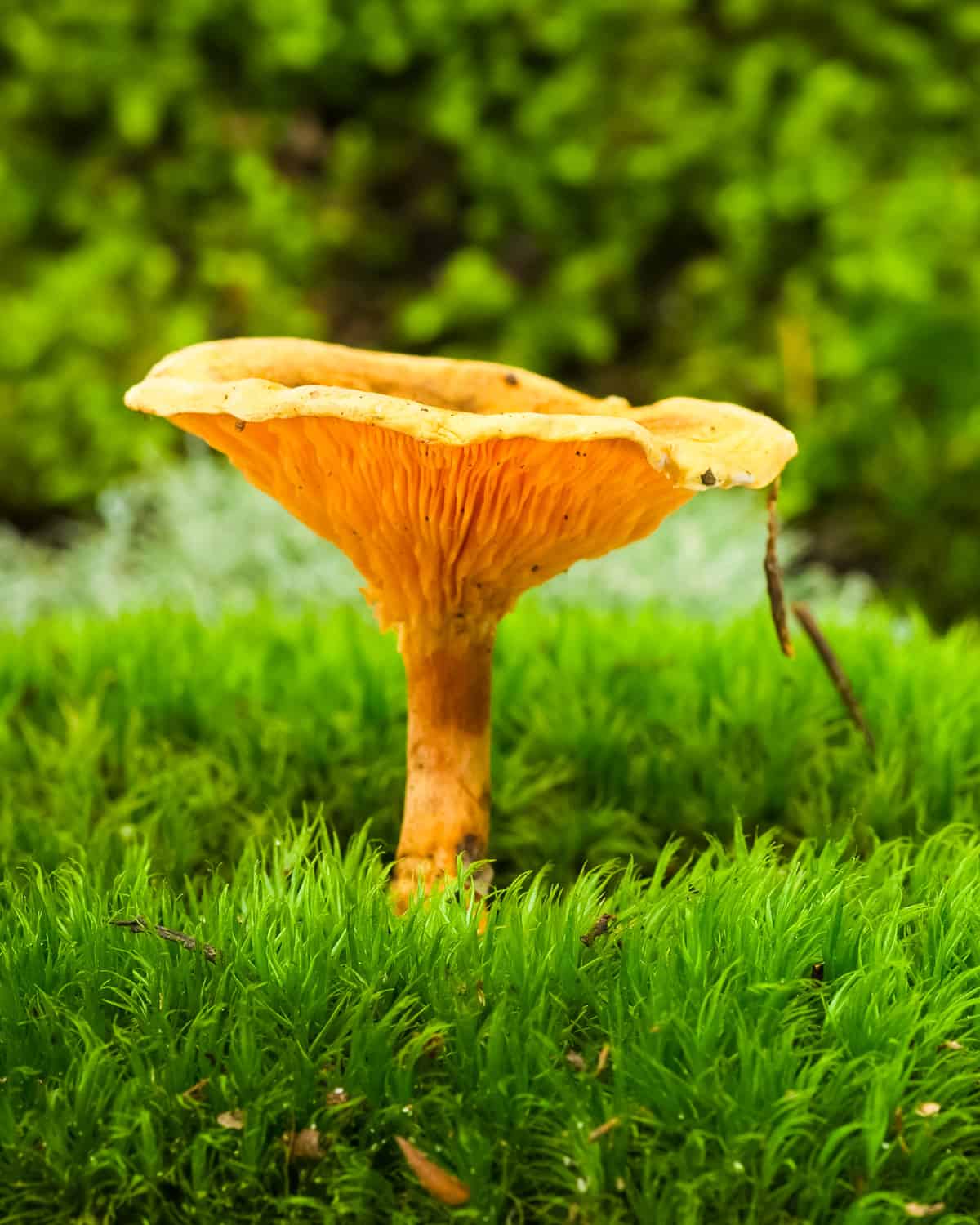
How to Harvest Chanterelle Mushrooms
When you find a patch of chanterelles, look for younger mushrooms as they will be better for eating. Older and larger chanterelles tend to be past their prime and may be soggy or infested with bugs. Leave the smallest ones to continue growing.
There is a bit of a debate on whether mushrooms should be plucked or cut from the ground. In recent years it’s been determined that it doesn’t really matter either way because all of the mycelium is underground and the mushroom is just the fruiting body. The mushrooms will come back year after year regardless.
It is often recommended to keep your foraged mushrooms in a mesh bag to help distribute the spores as you walk through the forest.
As with any mushroom or plant, don’t take everything you see! It’s a good rule to never take more than 30% of any given stand. I like this resource on responsible mushroom picking.
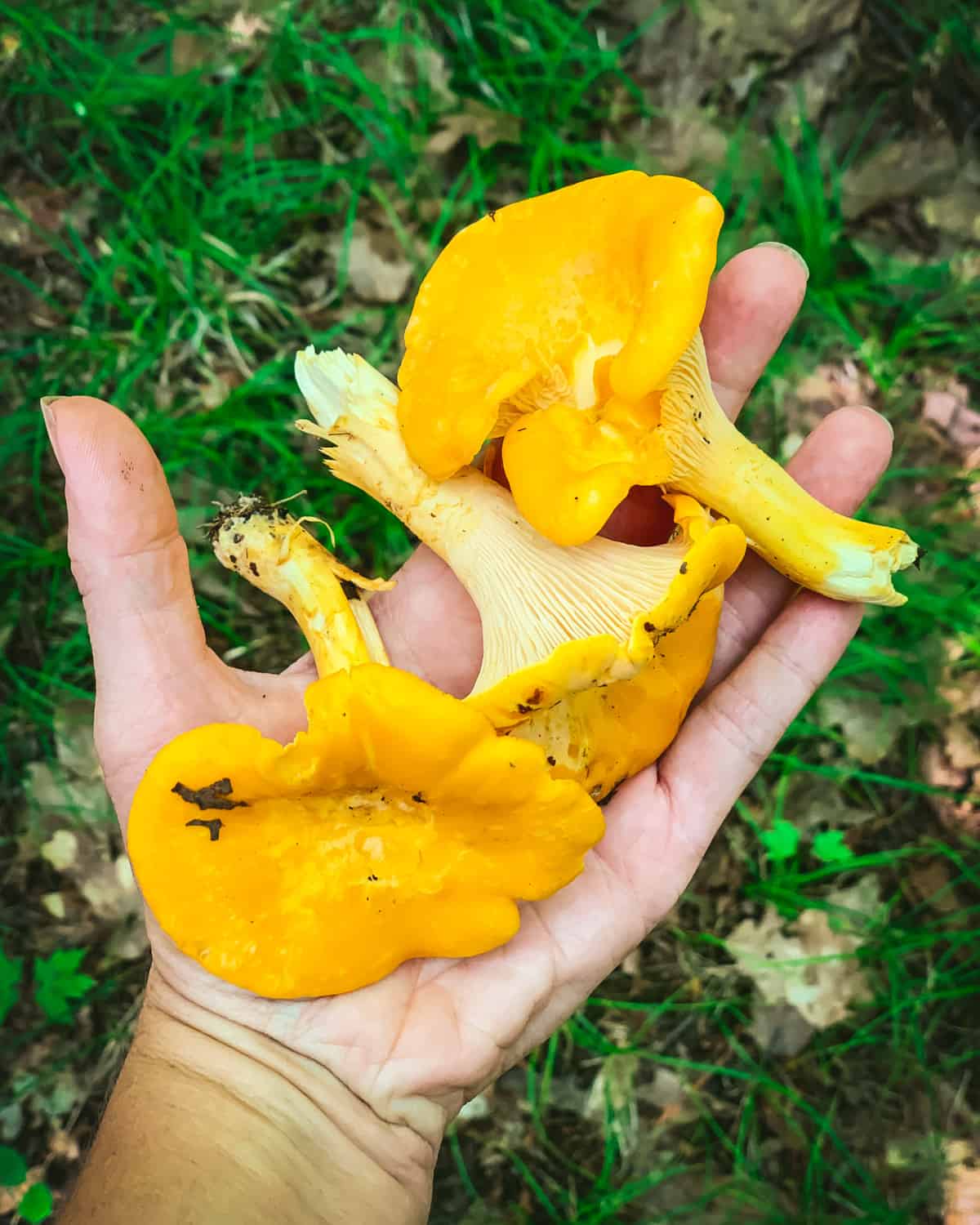
How to Cook Chanterelle Mushrooms
Chanterelle mushrooms are one of the best tasting wild mushrooms and are a favorite of many foragers, myself included! I think they are my favorite wild mushroom to eat.
Chanterelles are an excellent source of minerals, vitamin D, B vitamins, protein, and fiber. They also have anti-inflammatory benefits.
Once you get your foraged chanterelles home it’s time to start thinking about how you want to prepare them.
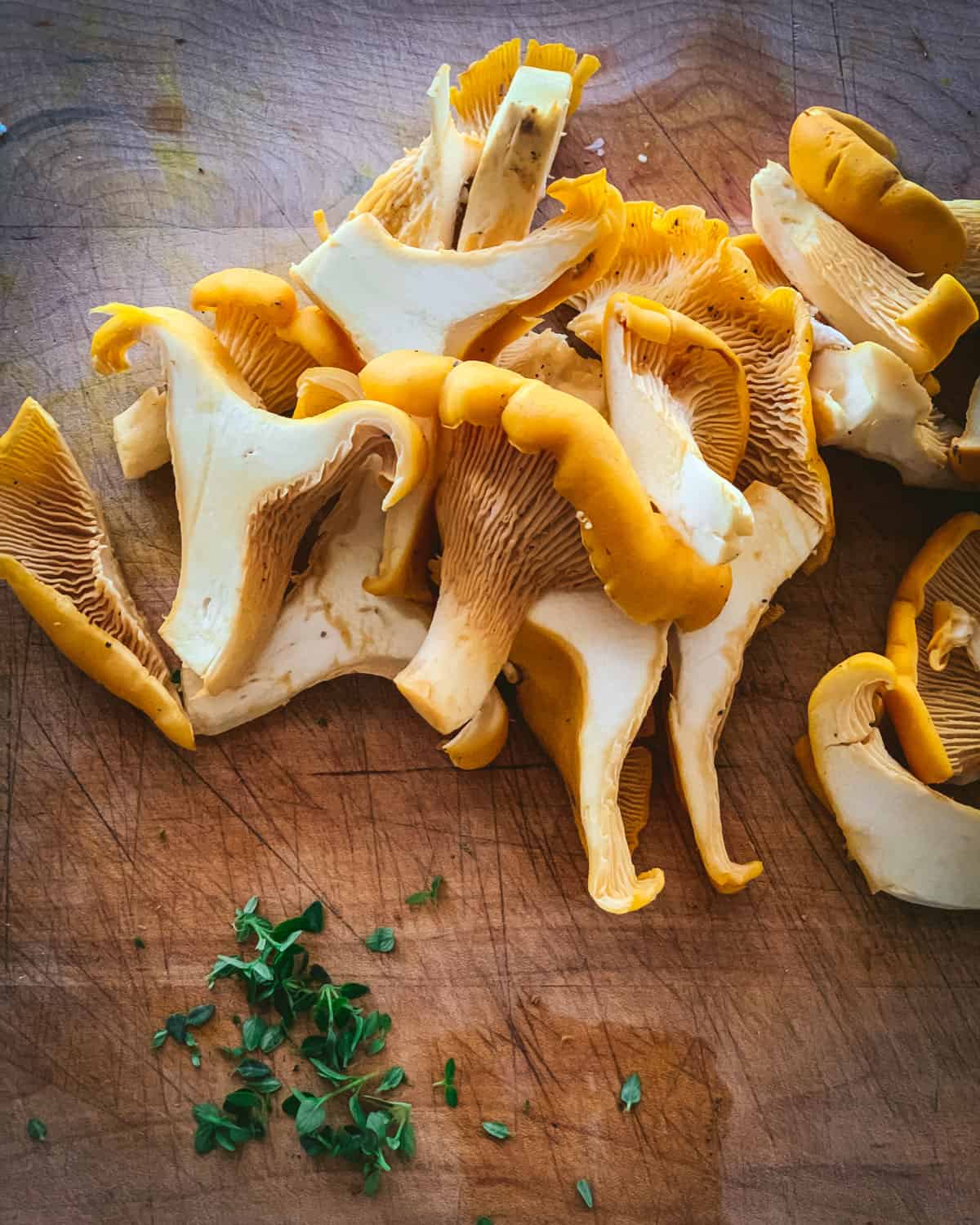
They are truly delicious and gourmet mushrooms and any chef would love to have some in their kitchen. So if you have them you should consider yourself lucky!
My favorite way to cook chanterelles is to saute them up in butter with a little bit of fresh thyme. Mushrooms and thyme go together really well, and butter goes good with anything (especially mushrooms!)
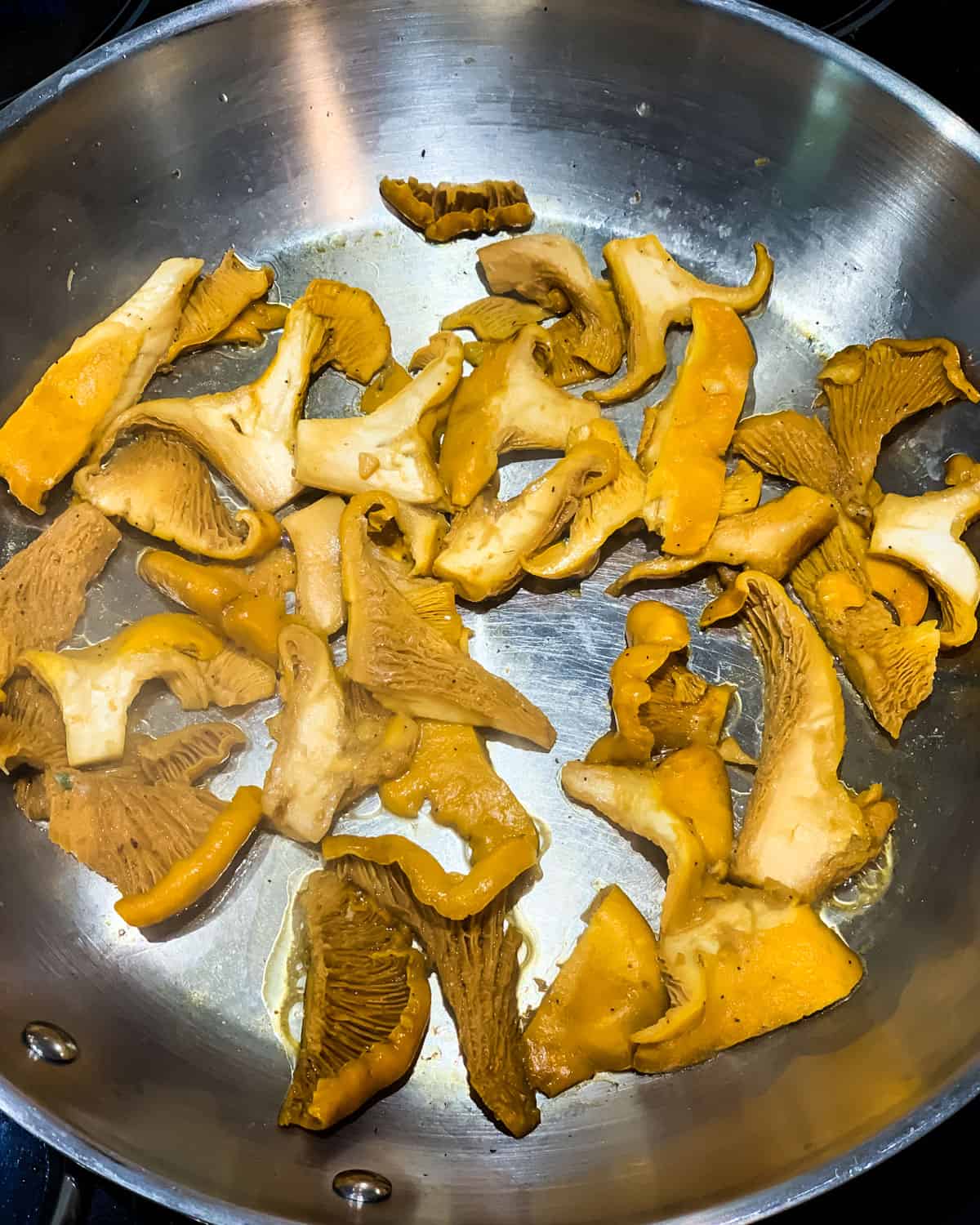
If you came upon a bumper crop of chanterelles you can get a little more creative with your dishes, such as a creamy chanterelle soup, or even a tart or quiche.
These simple sauteed chanterelles are so delicious, they never disappoint!
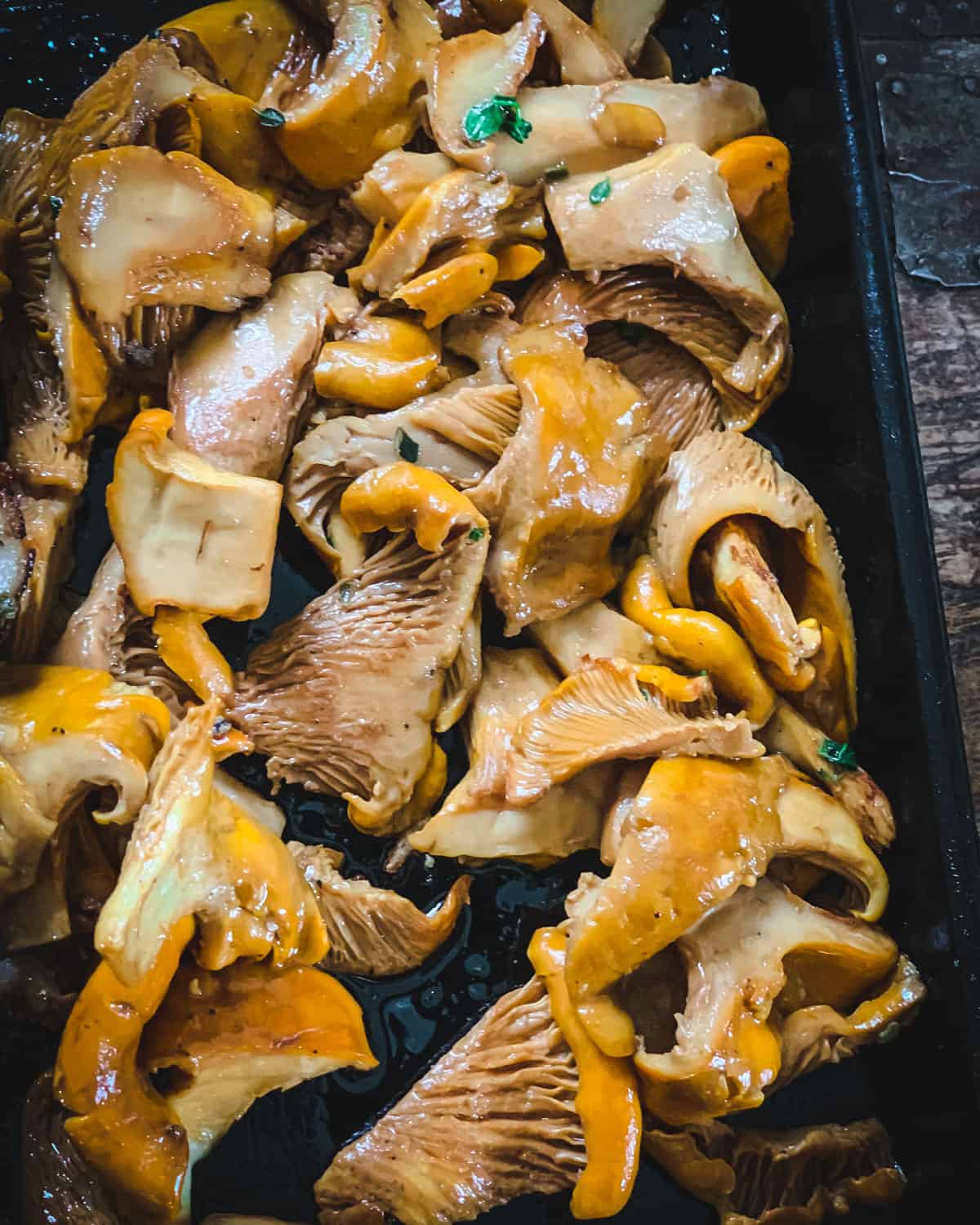
Just remember that they don’t stay fresh for long, so you’ll want to use them up quickly, within a few days of harvesting.
You can also dehydrate them for use later. I’ve never done this with chanterelles, but I’ve dried other mushrooms and it always works really well. Then you can eat chanterelles all year long!
Foraging for chanterelle mushrooms is a great way to spend a rainy summer or fall afternoon, even if you don’t find any.
Getting out in nature is really what it’s all about, and you’re bound to find something cool even if it’s not edible.
But, if you do find something useful the excitement that ensues is always the best feeling. So go out for a walk in the woods, breath in the fresh air, listen to the birds, and keep your eyes peeled for wild edible mushrooms!
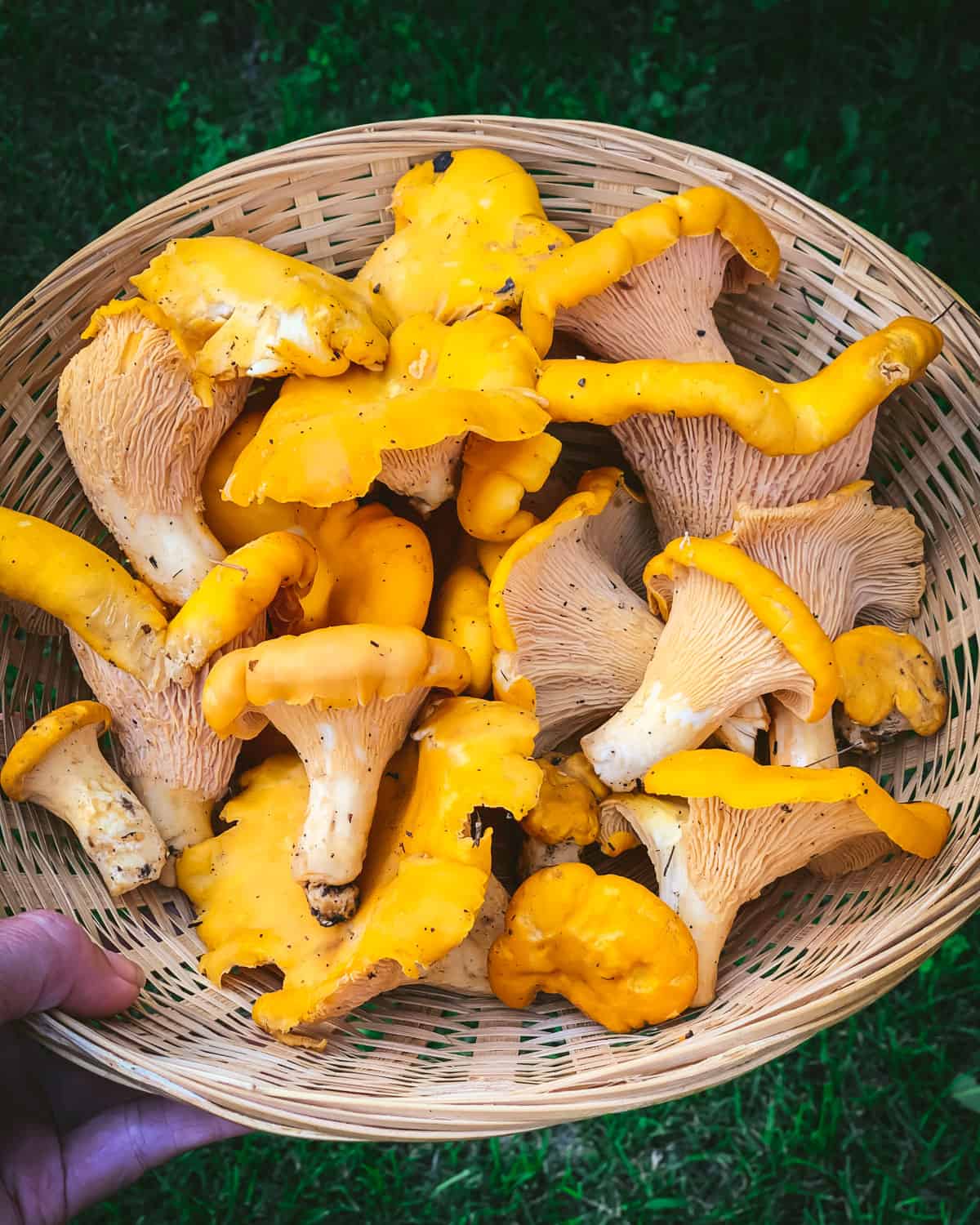
More Mushroom Foraging Guides
- Morel Mushrooms
- Yellowfoot Chanterelles
- Lion’s Mane Mushrooms
- Oyster Mushrooms
- Lobster Mushrooms
- Chaga Fungus
- 5 Easy to Identify Mushrooms
- Shaggy Mane Mushrooms

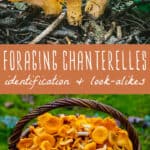

Thank you for this article, but I’m confused. In one uncaptioned picture there are several mushrooms in a hand that seem to have very defined gills, not the rough gills chanterelles have. Are they poisonous? I have ones that look exactly like that in my woods and assumed they were poisonous, but when I cut one the meat inside was white, not yellow like jack-o-lanterns. No big deal, but you may want to label the pictures.
Sorry about that. All the images, unless labelled as toxic, are chanterelles. The chanterelles in my hand do not have gills, they have blunt ridges that extend down the stem.
Live in Saskatchewan. CHANTERELLE capital. I saute in butter for 8 mins, vacuum seal, freeze..good for years.
Found a bunch in my sisters woods in northwest Pennsylvania over the weekend. (Late August)
Awesome!
Chanterelles really don’t rehydrate well. They stay pretty rubbery. I like to freeze them after a sauté if I’m lucky enough to find too many to eat right away.
I live in
L.A., LOWER ALABAMA. WE HAVE LOADS OF HUMIDITY AND OFTEN MUSHROOMS…..ARE THEY POISONOUS, OR ANY IN THE SOUTH EDIBLE? WE HAD TO CUT DOWN A DYING LARGE SUGAR MAPLE, BUT THE STUMP IS STILL IN GROUND. HUGE FIRM AND THICK MUSHROOMS ARE GROWING HALFMOON AROUND SIDES OF TRUNK. THEY ARE AT LEAST CLOSE TO 1 IN.THICK AND LARGE AS A PERSONS SMALL HAND, LIGHT IN COLOR. ARE THESE STUMP MOONS EDIBLE?….
Just please remember to cut them and leave the rooted area behind so they will grow more next year. If you pull them out then there will be less the next time around.
This is a complete myth. A mushroom’s mycelium run underneath the ground a very long distance. Pulling out the mushroom or simply snapping it off at the base does absolutely nothing to discourage their growth in the same area in the future.
I went out with a friend here in Finland yesterday and we found about 10 liters of chanterelles. My favorite way to preserve them is to clean and chop them saute them until most of the water evaporates. I divide them into single serving (usually 1 cup) freezer bags and put them in the freezer.
I’m so excited to learn more about foraging mushrooms! Chris at Joybilee Farm has some great posts on growing them yourself and I’d like to do that, too. However, if I can just find them for free…thanks for the great post!
They look so delicious! Never looked for these in the North East. Do you know if they grow here? I also cure mushrooms (pickle and place under oil) to preserve them for salads and appetizers through the winter.
I’m in Maine and pick them here.
yes i forage for them as soon as the weather turns wet and rainy..they flourish in one spot I know..and after a few days of soggy weather then sunshine its amazing how fast they pop up..
They do in the northeast kingdom in Vermont on the Canadian border during the last week in July
I am in northeast NY and just picked a batch today!
You mention that these are on the Westcoast. How about the Midwest? Specifically Wisconsin?
Awesome post! I have been hearing about chanterelles for a while now and this post is fantastically helpful!
We get them in our lawn every year in central Illinois! They’re on a slope and usually pop up when it’s wet. We eat them sautéed and my husband can also make a mean mushroom gravy!
Sounds like life is good in the NW!
Chanterelles are one of my favorite wild mushrooms. My best spot was ruined this year by marauding beavers that took down so many trees area dried up. Very disappointing.